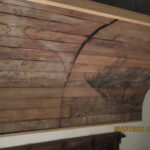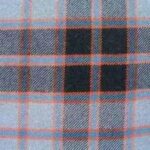And so we continue in the History Museum, we focus on the important things of course:
I have a great many pictures from this visit – and at the time I took them I just knew that they were important and I would remember…some of that knowledge has moved out!

For several centuries, tartan remained part of the everyday garb of the Highlander. Whilst tartan was worn in other parts of Scotland, it was in the Highlands that its development continued and so it became synonymous with the symbol of clan kinship.
Tartan was used to make the items of clothing which are today considered traditional Scottish dress, including the philabeg, or kilt, and of course the trews. These would be worn with shoes of untanned hide and the cuaran, a knee length boot also made from hide which was shaped to the leg and kept in place by thongs. A hat, or bonnet of knitted wool sporting a badge of the clan, usually a plant of flower, would sit proudly on the head of the clansman. The highly ornamented leather sporran worn in front of the kilt served as a purse completed the ensemble.
The women of the clan wore a curraichd of linen over their heads which fastened under their chin. The tonnag was a small square of tartan worn over the shoulders, and the arasaid was a long self-colored or tartan garment, which reached from the head to the ankles, pleated all round and fastened at the breast with a brooch and at the waist by a belt.
Early tartans were simple checks of perhaps only two or three colors. The colors were extracted mainly from dye-producing plants, roots, berries and trees local to a specific geographic area. These simple checks or tartans were worn by the people of the district where they were made, and as such became the area or clan tartan.
It is said that the weavers took great pain to give exact patterns of tartan by identifying each color of every thread upon a piece of wood known as a maide dalbh, or pattern stick. An account from 1572 records how a housewife gave colored wool to a weaver to make into cloth. In suing him before the magistrate she accused him of making the cloth to his ‘awin fasoun’, or own fashion, and not according to her instructions. She won her case and the naughty weaver was punished.
With the evolution of chemical dies, weavers were able to introduce more elaborate patterns including more vivid and varied colors. As clans grew and branched through birth, death or marriage, the newer clans evolved tartans of their own by adding an over stripe onto the basic pattern of the parent clan. http://www.historic-uk.com/HistoryUK/HistoryofScotland/The-History-of-Tartan/
TARTAN CATEGORISATION
- Clan/Family. Tartan associated to one’s family background. The Clan (or Family) tartan is worn by the clan’s members as well as well-wishers. If someone has a Scottish surname, there is probably a tartan associated to this name, too. Click here to search the Clan finder.
- Name. Tartan intended for anyone of that surname – be it an individual or the whole family. The registrant of such a tartan may be expected to have a number of people with that surname sign off on the design, as evidence that they approve of the registration. In some time such tartans may be accepted as Clan/Family ones if no other patterns are available.
- District. Tartan named after particular geographical area. District tartans may be symbols of countries, cities, provinces, states or even small towns. Such tartans are usually worn by those who feel a personal connection to the area that the tartan represents. Practically, it is often used also by those who cannot find their clan or family connection to any of the tartans.
- Portrait/Artefact. Tartan’s thread-count is taken from a real artifact, painting or an article of clothing. The Scottish Register of Tartans suggests including the tartan’s origin in its name.
- Corporate. Tartan which belongs to a particular company, organisation or group of people gathered around specific interests. The trend of creating corporate tartans has started in the 1980s and has remained continuously popular right up to the present day. Naturally, these tartans are worn only by employees or group members, and weaving of the tartan is normally restricted to company approved weavers only, to ensure distribution is controlled among approved wearers only.
- Commemorative. Tartans created in order to memorialise someone or something. They mark a special event or a person and may be worn by anyone who has an interest or who feel associated to the tartan’s theme.
- Fashion. Tartan brought to life because of commercial issues. The copyrights are owned by the commercial companies and un-approved mills are excluded from weaving them, unless the notes say different.
- Military. Tartans connected to the branches of the armed forces, which can be worn by any person with a genuine claim to affiliation with that branch. Volunteer branches are also included in this category.
- Royal. Tartan that is strictly connected to the Royal Family. These tartans are worn only by the members of the British Royal Family. However, few tartans considered as Royal ones (such as Royal Stewart) have no restriction and historically can be worn by any subject of that monarch (or, as with Royal Stewart, now anyone can wear it).
- Regimental. Similar to normal military tartans, however these are affiliated with a specific regiment, and really, only veterans or currently serving members of that regiment should wear these.
- Trade. Tartans which are used to represent other jobs, not related to the military. Trade tartans are however particularly popular among vocations with a strong military connection, such as the emergency services.
- Universal. Tartans intended for people with a link to Scotland, who wish to wear tartan but do cannot identify their clans or the districts his/her ancestors lived in. Universal tartans are also a good solution for those who have no particular connection to Scotland but are passionate fans and enthusiasts of all things Scottish!
My Family name is Gillis, we belong to the Clan MacPherson.

















I actually have scarves in our tartan:)